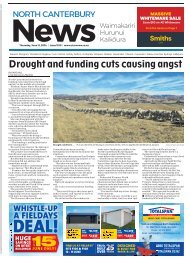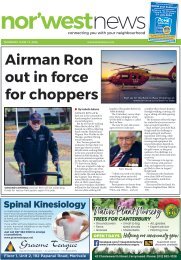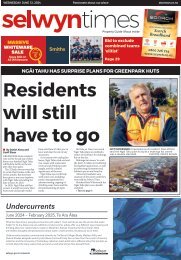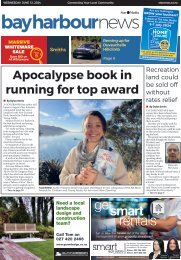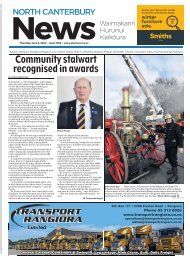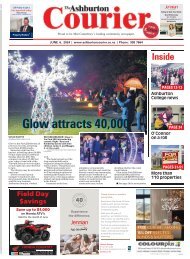Selwyn Times: September 01, 2021
Create successful ePaper yourself
Turn your PDF publications into a flip-book with our unique Google optimized e-Paper software.
Latest Canterbury news at starnews.co.nz<br />
Wednesday <strong>September</strong> 1 <strong>2021</strong> <strong>Selwyn</strong> <strong>Times</strong><br />
NEWS 13<br />
Steamer wreck mystery likely solved<br />
• By Susan Sandys<br />
THE MYSTERY of an unknown<br />
shipwreck in a remote part of<br />
Fiordland may have been solved.<br />
A cannon, found by a scientific<br />
expedition team from Willowbank<br />
Wildlife Reserve, is possibly<br />
from the Star of the South. The<br />
steamship wrecked in the area<br />
in 1865. Its passengers and crew<br />
were all rescued.<br />
The drawing of a galleon with<br />
names etched underneath in<br />
a nearby cave is unlikely to be<br />
related. They are believed to have<br />
been left by early sealers.<br />
Members of the expedition<br />
made the discovery of the cannon<br />
in June, as they searched for<br />
the elusive South Island kōkako.<br />
They unearthed the vintage<br />
naval gun by moving stones with<br />
their bare hands after spotting a<br />
patch of rust on the stony beach<br />
at Chalky Inlet. It followed them<br />
viewing the etchings in the cave<br />
the previous month, and they<br />
wondered if the cannon and<br />
etchings may be linked and both<br />
be evidence of an unknown<br />
shipwreck.<br />
Managing<br />
director Michael<br />
Willis, who<br />
lives in Halkett,<br />
said information<br />
which has<br />
surfaced since,<br />
suggested the<br />
Michael<br />
Willis<br />
cannon may<br />
have come from<br />
the shipwrecked<br />
Star of the South.<br />
The Star of the South was a<br />
West Coast trading ship with<br />
three masts. She was transporting<br />
cargo and passengers from<br />
Dunedin to Hokitika when she<br />
took shelter from stormy seas at<br />
Chalky Inlet. On December 15,<br />
1865, she struck a sunken rock<br />
and was beached on sandy shores<br />
to prevent her foundering.<br />
A newspaper article on Papers<br />
Past, discovered by a follower on<br />
the Willowbank Facebook page,<br />
suggests one of the ship’s cannons<br />
was taken to a nearby shore<br />
by a look-out party to be used as<br />
a signal gun. A January 18, 1866,<br />
The Press article details the efforts<br />
of two crew members going<br />
in the ship’s boat to the shore in<br />
the Cape Providence area, and<br />
climbing a hill to light a fire to<br />
alert passing ships so they could<br />
be rescued.<br />
“By the difficulty they had in<br />
ascending and descending the<br />
hill, they also ascertained that to<br />
convey to the summit the cannon<br />
they brought with them as a<br />
signal-gun, was out of the question,”<br />
the article says.<br />
This suggests that after arriving<br />
in the boat, they left the cannon<br />
behind on the beach as they<br />
climbed the hill.<br />
Willowbank general manager<br />
Dale Hedgcock said the area of<br />
the beach where he and his fellow<br />
team members found the cannon<br />
would have been an obvious location<br />
for the two Star of the South<br />
crewmen to land their boat,<br />
before walking along the beach<br />
for about 1km to access the hill<br />
referred to in the article.<br />
“That’s probably the only area<br />
you would try and land a boat,<br />
there’s so many rocks around,”<br />
Hedgcock said.<br />
Other articles on Papers Past<br />
reveal the more than 15 passengers<br />
and crew were lucky to be<br />
rescued from the remote location<br />
six days after the shipwreck, on<br />
December 21. Another steam<br />
ship, the William Miskin, happened<br />
to come across the wreck<br />
as she took shelter from stormy<br />
seas.<br />
“Through her providential<br />
arrival, the passengers and crew<br />
were saved much distress and<br />
inconvenience,” said a reporter in<br />
the January 20, 1866, edition of<br />
the Taranaki Herald.<br />
The passengers arrived at their<br />
original destination of Hokitika<br />
on December 27. The Star of the<br />
South was retrieved, but later<br />
stranded on a beach, at Napier in<br />
1870, before ultimately wrecking<br />
in 1884, on the mouth of the<br />
Grey River.<br />
Hedgcock said a maritime historian,<br />
archaeologist and DOC<br />
representative planned to visit<br />
the site and ultimately preserve<br />
the cannon. They hoped to determine<br />
whether it came from the<br />
Star of the South or an unknown<br />
shipwreck. The team was awaiting<br />
the right permissions in order<br />
to make the visit.<br />
Naval artillery expert Peter<br />
Cooke said the Star of the South<br />
story “seems to ring true” in<br />
STRANDED: The<br />
Star of the South<br />
continued in service<br />
after being retrieved<br />
from Chalky Inlet.<br />
This painting<br />
shows the steam<br />
ship stranded on<br />
a Napier beach in<br />
1870.<br />
answering the question as to how<br />
the cannon was buried on the<br />
beach at Chalky Inlet.<br />
“If that story places the wreck<br />
of the Star of the South or the<br />
people from it at this location,<br />
then I think that does solve the<br />
mystery,” Cooke said.<br />
He said merchant ships carried<br />
arms in the 1800s in case of attack<br />
from pirates. Additionally,<br />
cannons were used for signalling.<br />
They were fired as a ship came<br />
into harbour to alert the pilot<br />
boat to come out and guide the<br />
ship into port.<br />
“It’s great that it has been found<br />
and has a back story to it, because<br />
hopefully now some museum authorities<br />
will preserve it,” Cooke<br />
said.<br />
Weapons of that sort needed<br />
a special type of preservation<br />
involving an electrolysis bath to<br />
reverse the rusting process.<br />
Cooke said it was an exciting<br />
find, in that it referenced an event<br />
that went back to New Zealand’s<br />
early history.<br />
From looking at photos of<br />
the cannon, he determined it<br />
was a Carronade. These type of<br />
cannons were first used in 1779,<br />
and generally dated from at least<br />
1800. They were named after the<br />
Scottish foundry Carron where<br />
they were designed and made,<br />
initially for the Royal Navy.<br />
There were 37 other cannons of<br />
this type that he was aware of in<br />
New Zealand, most of them held<br />
in museums around the country.<br />
Department of Conservation<br />
senior heritage adviser Matthew<br />
Schmidt said the etchings which<br />
UNEARTHED: Dale Hedgcock and Mark<br />
Willis with the cannon they discovered on<br />
a beach in Chalky Inlet. Above: The Star<br />
of the South met her final demise on the<br />
Grey River mouth in 1884.<br />
had also been viewed by the Willowbank<br />
party, were possibly left<br />
by early sealers using the cave for<br />
shelter.<br />
He said the cave itself did not<br />
have a formal name, but the site<br />
was familiar with locals and formally<br />
recorded in the early 1980s.<br />
DOC issued a reminder after<br />
the cannon find about the importance<br />
of not disturbing heritage<br />
sites.<br />
However, Schmidt acknowledged<br />
the Willowbank team<br />
made the right decision following<br />
their find of the cannon to contact<br />
the Ministry for Culture and<br />
Heritage.<br />
“The immediate parties which<br />
additionally should have been<br />
contacted were Environment<br />
Southland and the Department<br />
of Conservation,” Schmidt said.<br />
However, Willis said if DOC<br />
wanted to be told, this information<br />
should be on the Ministry<br />
for Culture and Heritage website.<br />
Ten weeks after informing the<br />
ministry, he still had not heard<br />
back from anyone from the<br />
ministry.<br />
Meanwhile, while Willowbank<br />
initially hoped to obtain custodianship<br />
of the cannon, this now<br />
seems unlikely.<br />
“For finds like this, it is important<br />
for finders to work with local<br />
agencies and the community to<br />
ensure that if it is recovered and<br />
conserved, it is displayed locally<br />
so it remains part of the heritage<br />
story of Fiordland. The finders<br />
and conservators would then<br />
become part of that local heritage<br />
story,” Schmidt said.<br />
“Capital gain was a big<br />
influence...”<br />
MICHAEL WILLMER - RETIRED BUILDER,CABINET MAKER<br />
“..we knew there’d always be money left to help<br />
our kids - especially the grandchildren. But it was also the<br />
quality of the build that swayed us...it was very good.”<br />
There are many more reasons why Woodcroft Estate could be the right<br />
choice for you. Why not visit our website and discover just how much<br />
more there is to gain in your retirement living.<br />
VISIT US ONLINE | KARAKAPINES.CO.NZ<br />
TO DISCOVER HOW GOOD YOUR RETIREMENT LIVING COULD BE.<br />
34 KENDON DRIVE LEVI PARK, ROLLESTON | CORINNE 03 421 7796 | 021 292 1141 |<br />
SALES@WOODCROFTESTATE.CO.NZ |<br />
0800 KARAKA





